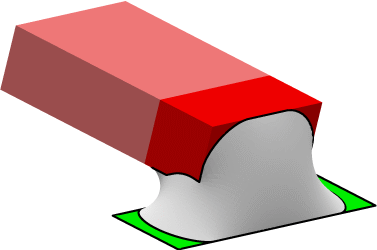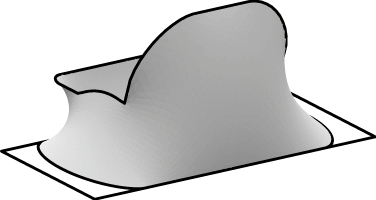Tombstone example home page
Next tombstone page
Previous tombstone page
Tombstone Example tomb-EE for the
Surface Evolver
[Click for the tomb-EE.fe datafile in a second window.]
This datafile deletes all the chip-solder contact facets of tomb-E.fe
and accounts for their effect on energy and volume with line integrals
along the contact edges.
 |
| Evolved surface, 5920 facets. |
 |
| The solder surface by itself. |
Notable features:
- There are now line integrals around the contact edges on the
chip, specified in the constraint definitions. My method of arriving
at these particular integrands is by slicing, with dy slices on the bottom,
dz slices on the sides, and dy slices on the front. Care must be taken
to be sure that all the edge orientations are properly accounted for.
Some people find the orientation of content integrals counterintuitive
(edge going in positive direction around a facet with outward normal
on a body contributes positively to the volume of the body). Be sure
to check your results numerically; here it is really handy to have
the all-facet version to compare with.
- Evolution goes much nicer without all the contact facets. Less
memory and computation time are needed, and the user can see all
the solder facets, so it is easier to see where special attention
is needed.
- The
gofar command in tomb-E.fe takes 51 seconds on my machine and
winds up with 9212 facets, while tomb-EE.fe takes 33 seconds and winds
up with 5920 facets.
Tombstone example home page
Next tombstone page
Previous tombstone page
Surface Evolver home page
Ken Brakke's home page



